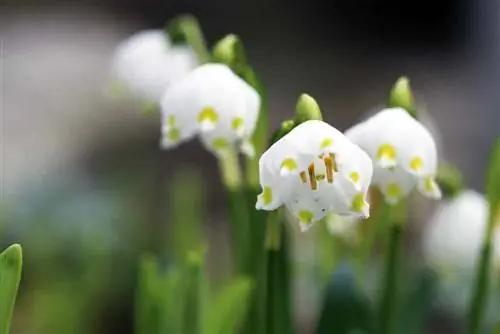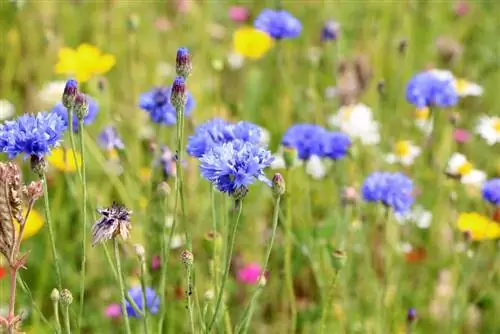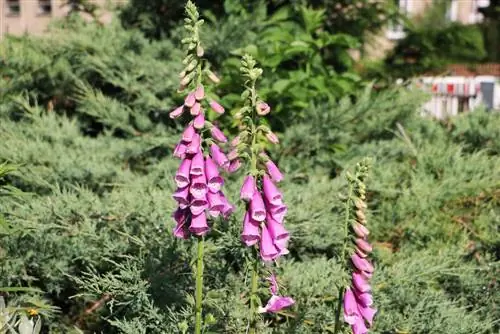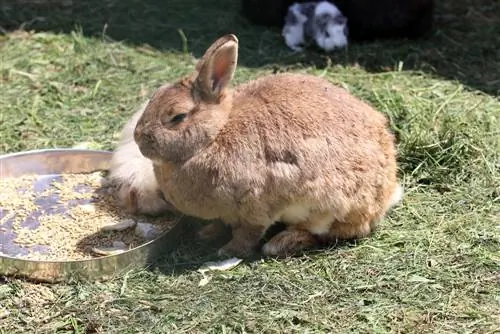- Author admin [email protected].
- Public 2023-12-17 03:39.
- Last modified 2025-01-24 12:45.
After weeks of gray desolation, nature finally wakes up from hibernation in spring. She immediately digs deep into the paint box and dresses the first flowers in all the colors she can find. Add a pinch of fragrance and you have an impressive range of flowers. So everyone can create their own idea of spring. Which colors would you like?
White, like a final snow greeting
Snowdrop (Galanthus)
Snowdrops are the first flowers to break through the gray of winter and give us a little foretaste of spring. Not only is the color of their flowers reminiscent of snow, their blossoming can also take place in the middle of the snow. They have to be planted out in the fall and then simply left alone. They don't like too much care. The small white flowers look great in combination with other early bloomers.
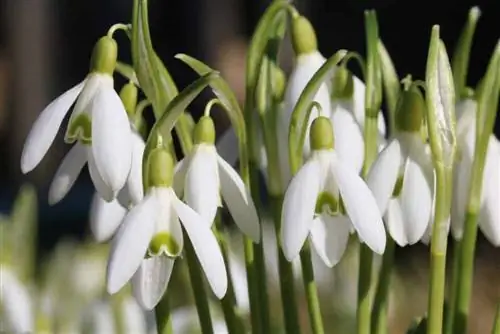
Many snowdrop varieties tend to go wild and conquer an ever larger area year after year. If you don't have a garden but love snowdrops, you can also keep the delicate flowers in flower pots. The flower stems are a pretty eye-catcher in the vase, but unfortunately they last far too short.
Lily of the valley (Convallaria majalis)
They like places that other plants avoid. They can be partially shaded and even shady. That's why they like to settle under trees and bushes. The soil should only be moist, warm and nutrient-rich. Most of the year they are not particularly noticeable. But in spring the small stems, decorated with white bells, appear in abundance and delight with their purist simplicity.
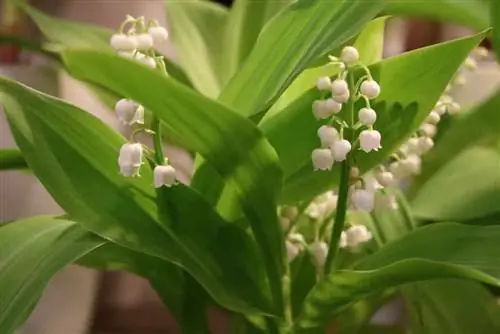
In June or July they can be easily propagated by division. The flowers often end up in a vase as a small bouquet. But be careful: lilies of the valley are poisonous, be careful when touching them.
Yellow, like the shining sun
Daffodil (Narcissus pseudonarcissus)
For many people, yellow is the color of spring. When the yellow daffodils are in full bloom, you know spring is here. They can now be discovered everywhere in parks, gardens, on balconies or on windowsills. They are also available in white or with a touch of orange. But the mass is bright yellow like the sun.
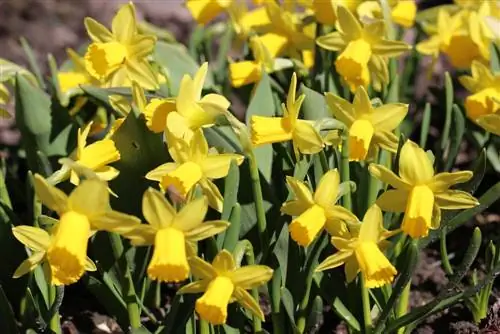
Bulbs that have already been sprouted can bloom on the windowsill in late winter. They can be planted until the first frosts, although September is the ideal month for planting daffodils. They are not as sensitive to moisture as other bulb flowers. They are easy to care for and are happy with a little compost in the spring.
Red in all shades
Ranunculus (Ranunculus)
The ranunculus had been forgotten for a long time and is now in great demand again. Quite rightly so, as they impress with beautiful flowers consisting of many rows of leaves. Thanks to the strong tones, the flowers contrast with the green leaves. They are mainly available in all shades of red.
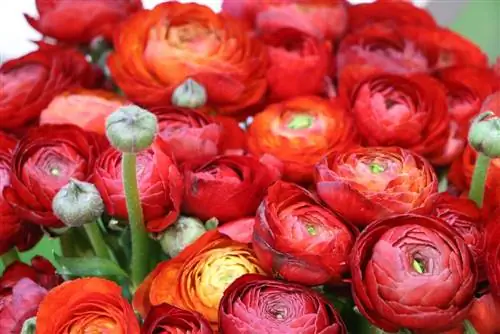
They are usually planted in pots and boxes to decorate balconies or terraces. They are offered in stores early on and are tempting to buy even on cold days. However, they come from the warm Orient and do not tolerate frost well. On very cold days they need to be protected from the cold on the balcony or brought into the warmth.
Ritterstern (Hippeastrum)
The knight's star is also widely known as amaryllis. The onion can be purchased commercially planted out in pots in winter. A flower stalk, sometimes two, quickly grows up on a sunny windowsill. Several large, funnel-shaped flowers then form on the approximately 30 cm high shaft.
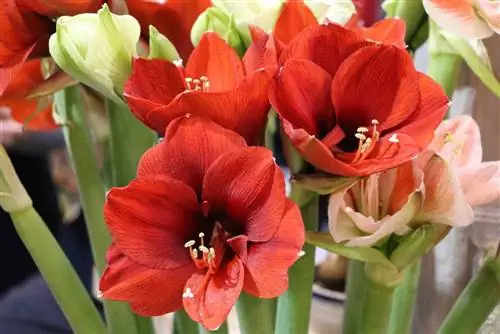
The range of knight stars is supplemented by white, pink or even multi-colored variants. The amaryllis is mainly kept as a houseplant that is allowed to shine on its own. During the flowering period it can be watered generously over the saucer.
Note:
The amaryllis is ideal as a cut flower. However, it is poisonous and can cause contact allergies.
Blue, like the cloudless sky
Harebells (Hyacinthoides)
The little harebells are quite undemanding bulbous plants. Once planted in autumn, they bloom again every spring. They are hardy and can simply be left in the ground. A few horn shavings are sufficient as fertilizer. The gardener is happy about so little work.
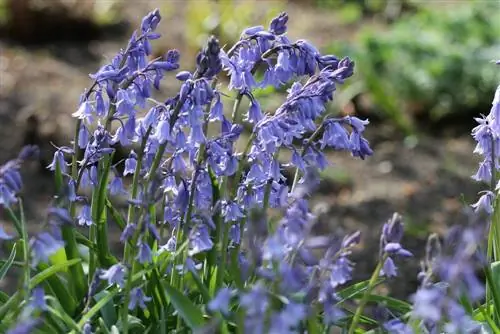
Since the harebell spreads quickly on its own and is happy with almost any space, it is well suited for natural gardens. The typical color of the small bell-shaped flowers is sky blue. Occasionally they can also be found in white and pink.
Grape Hyacinth (Muscari)
As early as March, the grape hyacinths delight us with their beautiful blue flowers. They are much more rarely seen in white or pink. They usually come in small groups and become more and more numerous over the years. The grape hyacinth tends to spread on its own and tends to go wild. Their requirements are low, but it shouldn't be too shady, otherwise the flowers will be sparse.
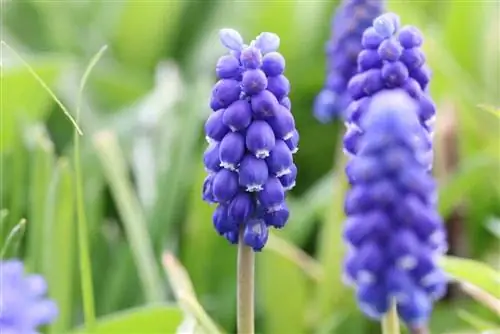
Plant the bulbs of this early bloomer in the fall, or grow them indoors. Your permanent place in the garden should be well-drained. If necessary, mix in some sand. The grape hyacinths are hardy and perennial and will turn the garden blue every year. They also do well in pots.
Forget-me-not (Myosotis)
Its delicate blue little flowers represent loy alty, longing, memory. The biennial plant is most commonly found in gardens. It is grown from seeds and requires well-drained soil. June and July are the optimal months for sowing. Choose a sunny or semi-shady place. The flowers only follow the following year from March to May.
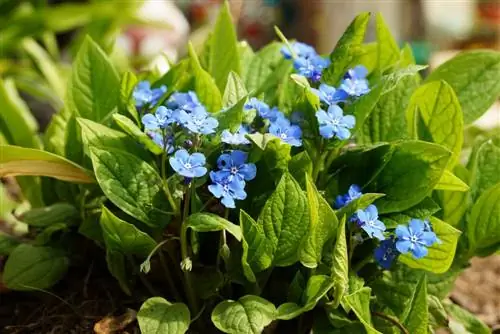
If forget-me-not is left alone, it will continue to sow itself. In addition to the usual blue, some varieties also bloom in white and pink.
Tip:
Forget-me-not is ideal for filling gaps in the flower bed.
Gentian (Gentiana)
The gentian flowers blue, blue, that is well known. Some species bloom in spring and offer the most intense blue to be found in the garden. They are planted in humus-rich soil in spring or autumn. The location must not be too sunny. Once planted, the gentian no longer wants to be disturbed.
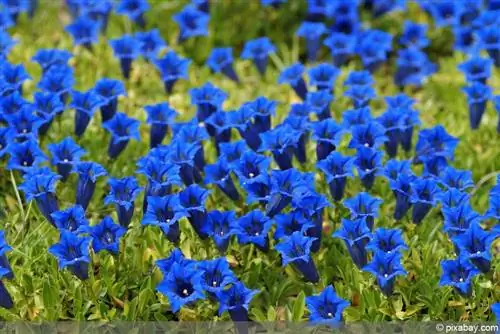
It should not be missing from any rock or natural garden. It is also good as a gap filler. And if you don't like blue, you can also buy it in a few other colors.
Purple, from delicate to intense
Crocuses (Crocus)
As soon as it gets a little warmer, they sprout out of the ground everywhere. Its flowers create white, yellow and especially purple splashes of color in the green lawn. As early as February they bring us a piece of spring. They develop their effect in groups and should therefore not be planted individually.
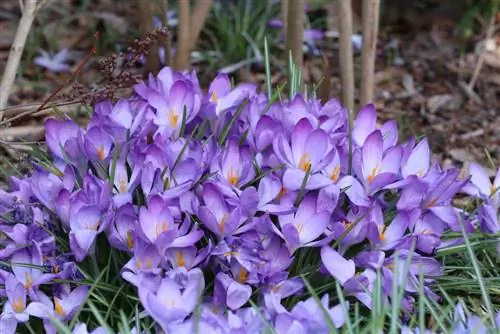
After they are planted out, they hardly require any care.
Tip:
Don't cut off the leaves immediately after the flowering phase, as the plant is still gathering strength for the next season. It's better to wait until they turn yellow.
Horn Violet (Viola cornuta)
Few types of flowers bloom as persistently and profusely as the horned violet. The first flowers appear as early as March. Intense purple is the color it prefers to appear in, including attractive patterns. Of course, the horned violet is now also available in many other tones. Especially varieties in which different colored leaves are combined with each other bring a colorful spring feeling.
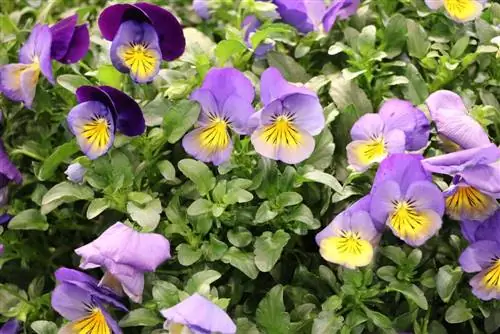
It thrives practically anywhere, in the garden, in pots and window boxes. As an edging for beds or in conjunction with other spring flowers. Normal soil enriched with fertilizer is enough for them to develop the sea of flowers. For early flowering, seeds can be sown on the windowsill in January.
Spring anemone
The tubers come into the ground in autumn and only hibernate for a short time. The usually purple-flowering spring anemone is one of the first signs of spring. They are also available in more delicate shades of pink or completely white.
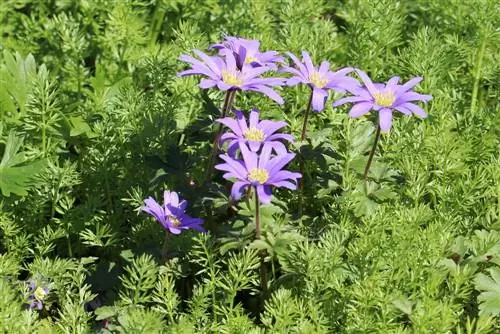
The wood anemones, which bloom in spring, like to grow under trees and still enjoy the first rays of sunshine of the year. Because they bloom from February when the trees are still bare. They spread themselves via rhizomes and seeds and form beautiful carpets of flowers over the years.
Colorful, fulfills every color wish
Daisies (Bellis)
The wild daisy is so popular in flower meadows that several cultivated forms have emerged from it. Bellis as a “de luxe” variant, so to speak. Numerous, bulging flower heads in the most vibrant colors decorate each individual plant. The entire color range is represented, from white to pink to dark red. His beauty has given him affectionate names such as Thousand Beautiful and Little Sweetheart.
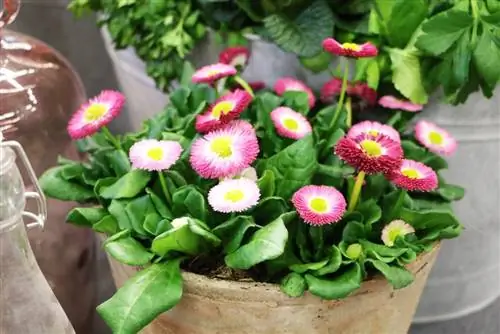
It looks particularly good as a path border in the garden, in borders or in the plant bowl with other spring flowers. It is most convenient to buy early plants commercially in spring. They can also be sown in May or June, but will not bloom until the following year.
Tip:
If the garden soil suits the Bellis, they will spread widely. Cut off spent flowers if you do not want them to spread.
Tulips (Tulipa)
A spring without tulips? Unthinkable! The elegant shape of the flowers and the bright colors make this flower a favorite of spring. The more of them come together, the more impressive the overall picture is. Only one tulip in bright blue has not yet been created; all other colors are already represented. There are also some colorful, patterned variants.

Filled shapes or curled leaves also enrich the variety. If you don't just want to buy tulip bouquets from the flower shop, you can bury tulip bulbs in sandy soil in the fall and wait for spring.
Garden Pansies (Viola wittrockiana)
Their flower shape is similar to horned violets, but is several times larger than them. Garden pansies also bloom profusely and in all sorts of colors and color combinations. They can be easily propagated from seeds sown in the fall. The new plants will bloom the following spring.
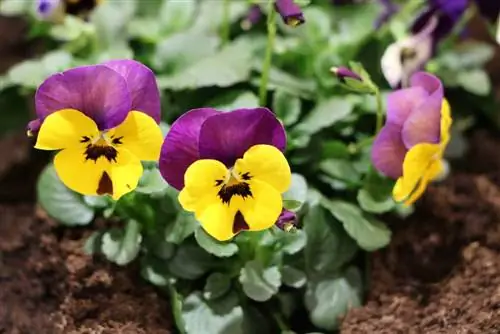
If you don't have a lot of patience, you can buy ready-made plants cheaply in stores everywhere and plant them in beds or flower boxes from mid-March. They like it moist, but shy away from too much moisture. Any dead flowers should be cleaned out regularly, then they will bloom even more extensively.
Hyacinth (Hyacinthus)
Other flowers would be happy with just a fraction of the fragrance intensity that every hyacinth exudes with ease. Therefore, it provides the scent of spring wonderfully in the midst of odorless flower varieties. Thanks to its enormous variety of colors, it fits into many arrangements.
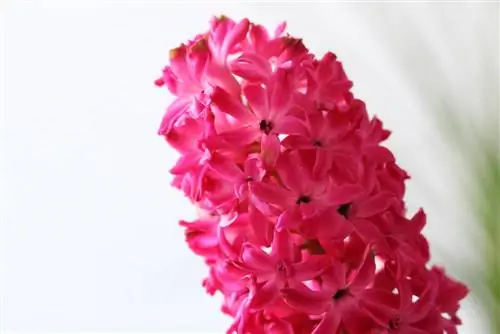
They come in white, yellow, orange, red, pink, purple and hot pink. She loves the freedom in the garden as well as company in a plant bowl. She likes sunny and warm places. It's best to put it in the ground in October or November, where it waits patiently for spring. Moisture and nutrients are important to her in the growth phase.
Iris (Iris)
The iris is a diverse flower that blooms in many colors. The magnificent flowers are even available in “almost black”. The first varieties start to bloom in February. The reticulated iris is small in growth and is therefore well suited for a rock garden or for container planting. Bearded iris loves sun and tolerates drought well. Sword iris, on the other hand, feels at home in damp locations, such as at the edge of a pond.
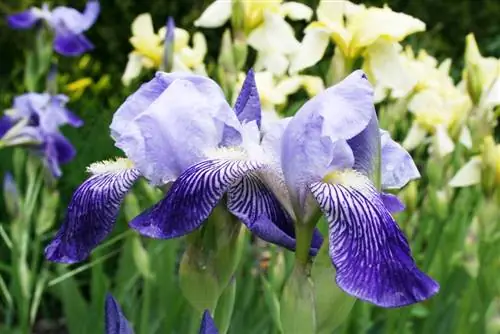
Most varieties of iris are perennial plants that are propagated via rhizomes. Net leaf iris forms small bulb. The rhizomes and bulbs are best planted from August to October. Plants purchased in pots, on the other hand, can be planted in the garden at any time from spring to autumn.
Primrose (Primula)
The primrose is one of the first flowers to bloom and in countless colors. It is a standard offering in the supermarket and its small size gives it a safe place in spring floral arrangements. She has been with us for what feels like an eternity and is still a regular companion for loyal souls.

If you want to rediscover the primrose, it's best to buy plants from stores in spring and plant them in the garden or decorate the windowsill with them. They like moist soil and a bright location but not too sunny.

